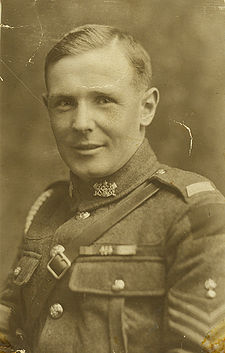Oliver, George Johnston
| George Johnston Oliver | |
|---|---|
| 23 February 1892 – 1968 | |
 | |
| Place of birth | Dunbar Berwickshire, Scotland |
| Place of burial | Brandon Manitoba |
| Allegiance | Canada |
| Service/branch | Canadian Army |
| Rank | Sergeant |
| Awards | DCM, MM with 2 bars |
Sergeant George Johnston Oliver (23 February 1892 – 1968) was a soldier of the First World War. He distinguished himself in major battles and was awarded the Distinguished Conduct Medal as well as the Military Medal with two bars, one of only five Canadians in the First World War to have been recognized as such.[1]
Early Life
George Johnston Oliver was born in Dunbar Berwickshire, Scotland on 23 February 1892. He immigrated to Canada with his family in 1907.
Service
He enlisted with the 12th Manitoba Dragoons when war was declared in 1914 and arrived with the 1st Canadian Division at St. Nazaire on 1 April 1915. Oliver served as an infantryman in the 5th Battalion, experiencing the first German gas attacks on the Western Front at the Second Battle of Ypres and the fighting at Festubert before being attached to the 2nd Canadian Infantry Brigade Headquarters as a signaller. He was then transferred to the 1st Canadian Divisional Signal Company on 21 December 1915.
As part of No. 3 Section providing communications to the 2nd Canadian Infantry Brigade Headquarters, he spent the remainder of the war as a lineman, maintaining telephone communications between the attacking battalions and 2nd Brigade Headquarters. This was a very dangerous job that exposed the men to enemy fire as they struggled through the heavily shelled landscapes, installing and repairing the telephone lines. George served throughout 1916, surviving all the battles unscathed, including the bloody fighting on the Somme. The attack on Vimy Ridge, which began at 0530 on 9 April, 1917 the Brigade Signal Sections moved up following the third wave of attacking infantry. No. 3 Section sent an advanced party immediately behind the 7th Canadian Infantry Battalion in the center of the 2nd Brigade attack. This advanced party laid two lines between the attacking battalions and the Brigade Report center. This work was so efficiently carried out that all Battalions were in contact with the Brigade Headquarters by 0900 hours. Signaller Oliver was singled out in the war diary, for his conduct at Vimy Ridge. George was subsequently awarded the Military Medal[2] for bravery for this action. On 5 June 1917 he was promoted to Acting Corporal. The victory at Vimy Ridge was followed by successes at Arleaux and Fresnoy. The next major battle for the Canadian Corps was at Hill 70. The assaulting elements of 2nd Canadian Infantry Brigade went over the top at 0425 on 15 August 1917. The brigade moved back to rest on 19 August. Throughout the attack, signallers again followed the infantry closely and were able to ensure excellent telephone communications. Acting Corporal Oliver was awarded a second Military Medal[3] for bravery at Hill 70.
The year 1917 closed with costly Canadian attacks at Passchendaele. The 2nd Canadian Infantry Brigade was part of the final attacks on 10 November which were designed to secure the Canadian hold on the highest portions of the Passchendaele Ridge, namely: Hill 62, Venture Farm and Vindictive Crossroads. Acting Corporal Oliver was awarded his third Military Medal[4] for bravery for his actions in supporting the capture of Hill 62 by the 7th and 8th Canadian Infantry Battalions. George was made a substantive Corporal on 26 December.
In 1918, the Canadian Corps helped to defeat the German spring offensive, and then lead the Allied attacks that ultimately broke the stalemate on the Western Front. These attacks began on 8 August 1918 at Amiens and continued until the Armistice on 11 November. Corporal Oliver was awarded the Distinguished Conduct Medal[5] that fall.
Personal Life
In October 1917, when he was granted leave, George went back to Leith, Scotland, and married Isabella Fisher Borthwick, his childhood sweetheart.
After the war he and his wife returned home to Brandon Manitoba where George got a job working for the Manitoba Telephone System in 1919. He and his wife had four children. George led a full life and was a Scout Master in the 20s and 30s, served with the Veteran Guard of Canada during the Second World War, was honoured with the Medal of Serving Brothers of Order of St. John, and retired after 37 years with the Manitoba Telephone System in 1956. George died in 1968 and is buried beside his wife, who died in 1974, in Brandon Cemetery.
Distinguished Conduct Medal Citation
Sergeant Oliver's DCM citation[6] reads:
Military Medal Citation
Cpl Oliver's MM citation reads:
First Bar to the Military Medal Citation
Cpl Oliver's citation for his first bar to the MM reads:
Second Bar to the Military Medal Citation
Cpl Oliver's citation for his second bar to the MM reads:
Related Items
References
- ↑ with material from an article by Brigadier-General (Ret'd) Don Banks CMM, CD which appeared in the magazine Remembrance: A salute to Canada's Fallen, Volume 2 published by the National Wall of Remembrance Association.
- ↑ The London Gazette, Supplement 30172. 6 July, 1917. Page 6843.
- ↑ The London Gazette, Supplement 30389. 16 November, 1917. Page 11961.
- ↑ The London Gazette, Supplement 30578. 12 March, 1918. Page 3223.
- ↑ The London Gazette, Supplement 31225. 11 March, 1919. Page 3391.
- ↑ The London Gazette, Supplement 31668. 28 November, 1919. Page 14902.













